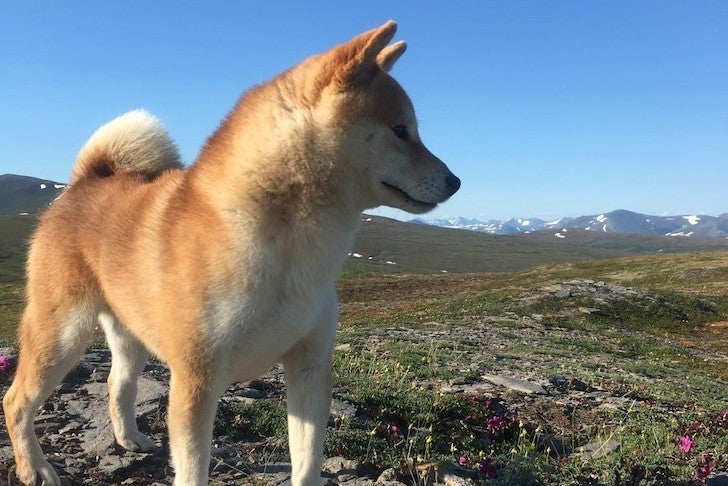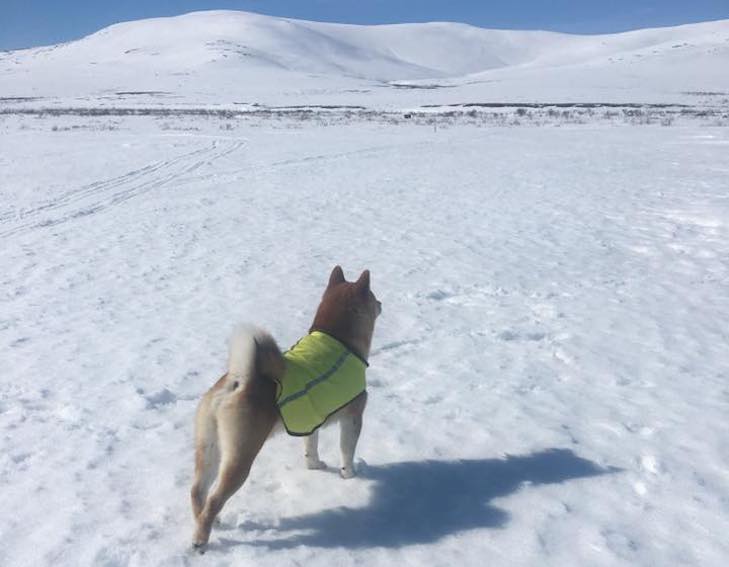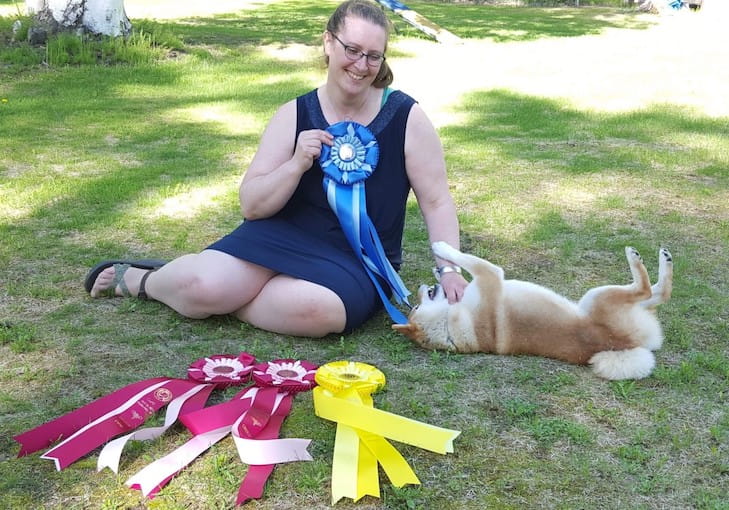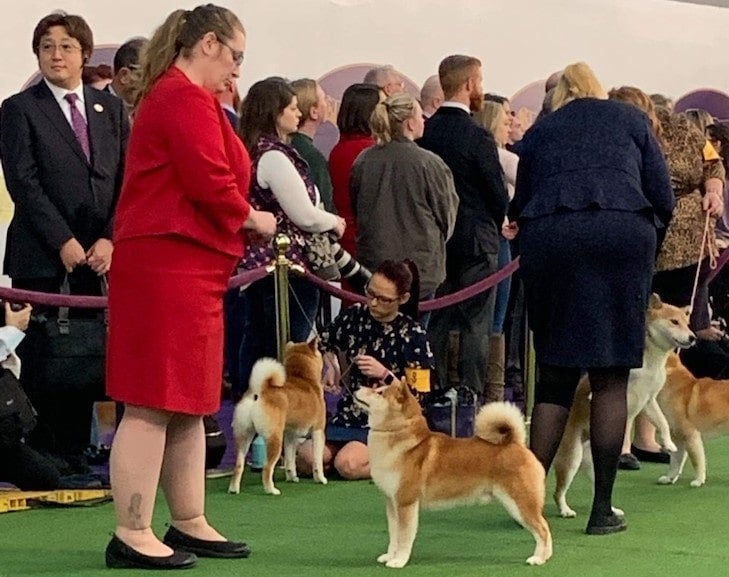
If you thought your travel and entry to that last dog show was a challenge, think again!
For most involved in conformation, logistics are nothing compared to the anxiety and challenging weather scenarios that confront Letty Hughes and her Shiba Inu, Ryouta, each time out. While the Nome, Alaska-based pair bond with skill and gusto, it’s the unknown that propels them into a psychological cul-de-sac before heading to the Lower 48, and even shows in their home state.
Nome is a coastal Bering Sea community on Norton Sound, 540 air miles north of Anchorage. Driving to Nome is impossible since the community is not connected to Alaska’s road system. The town of approximately 3,800 is 160 miles from Russia and 102 miles south of the Arctic Circle. It can be reached by boat and some snowmobile or dogsled trails. However, no state ferries serve the community, either. That means Alaska Airlines is the pair’s main conduit to all shows.
“A lot of expense and time goes into every decision I make to enter a show,” emphasizes Hughes, a National Park Service wildlife biologist for the Bering Land Bridge National Preserve and lead biologist for muskoxen for the NPS Arctic Vital Sign Network.

No Place Like Nome, Alaska
Schedules, expenses, seasonality, dog preparedness, house sitter availability, and judging lineups all factor into the entry process. Hughes also makes decisions based on the type of show, past entry numbers, and how far she may have to drive if Alaska Airlines doesn’t fly directly into the area.
For the past few years, the 5-year-old Ryouta has been entered in an average of 25 shows annually. Larger shows attended include the AKC National Championship presented by Royal Canin each December in Florida, and the Westminster Kennel Club Dog Show in New York City in February, both right in the heart of winter travel challenges. The enterprising Hughes also campaigns a Norwegian Elkhound and another young Shiba Inu.
Alaska Airlines is the only commercial passenger airline to fly in and out of Nome, offering two flights daily contingent on weather. This first travel leg often transports Hughes and her four-legged companions to Anchorage. Flight times range from 1½ to 3½ hours depending on the time of day and whether there is a stop. The majority of the shows she attends require her and the dogs to take three flights.
“That’s a lot of air travel for any dog,” says Hughes. “It challenges any Alaska exhibitor to plan ahead and be smart about flights My chief concern here is the welfare of the dogs.”
Living in Northwest Alaska means weather often dictates activities and travel. Major storms and thick coastal fog raise havoc and prevent planes from flying. If Hughes misses her flight out of Anchorage, the chance of making a show is unlikely. She always prepares to alter travel from Nome to Anchorage in the event the weather looks to be an issue. It’s not unusual for Hughes to change tickets at the last minute for these reasons.

Not So Little Details
The challenges work in reverse fashion, too. When that happens, Hughes and her dogs overnight in the Anchorage airport. Usually, it’s only for a day, but if longer, it requires both her dog sitter at home and her dogs in boarding kennels in Nome to extend their stays. It’s not unusual for Hughes and the dogs to arrive in Anchorage at 2 a.m. or later. Then, she’ll stretch the dogs’ legs after the long flight and find a secluded area in the airport to get a little sleep with the dogs crated alongside.
“I look for an area that doesn’t have other people nearby,” she says, “But inevitably, a passenger will decide that sitting right next to me and the dogs is a good choice. I shake my head and the only thing I can guess is they feel more comfortable with the dogs around.”
The Alaska dog community is a tightly bonded group, says Hughes, always willing to assist one another. They go above and beyond, she insists, because they want to help one another achieve goals in the ring.
“It might be sharing grooming space or being invited by a handler to groom your dog at their set-up,” says Hughes. “It could be a fellow exhibitor willing to load an extra crate into their vehicle because they know you are restricted with luggage. Or someone willing to pick you up at the airport. It’s those little details that are not so little that help make the travel challenges for Alaskans a lot smoother and less stressful.”
Hughes, who has lived in Nome since 2008, has owned Shibas since 2001. She had been showing a Chihuahua when she first came across a black-and-tan Shiba and fell in love.
“The more I researched the breed, the more I was convinced it was the one for me,” says Hughes. “A big dog in a medium body that is extremely intelligent, independent, stubborn, challenging, yet hardy, active, and healthy. A breed that makes you think outside the box when it comes to training and handling.”

It Takes A Village
Living in Nome and competing in the Lower 48 serves up all the ingredients for potentially nightmarish excursions. Hughes recounts one particular December 2017 journey with Ryouta to the AKC National Championship in Orlando.
Hours before departing Nome, Hughes realized the group she was staying with wouldn’t arrive in Orlando until a few days after her, leaving her without a hotel room. Fortunately, she was able to find a last-minute room near the show site. However, that was just the beginning.
To make matters worse, Hughes’ bag with her clothing was misplaced on the flight from Portland. She was due to show Ryouta the next day. Working with the airlines, she was able to rent a car and purchase a new show outfit nearby. Her bags ultimately arrived three or four days later. Still, there were more headaches to come.
The next morning, Hughes woke up feeling ill and decided to visit the emergency room. As no one in her group knew which hotel she was in, she had the hotel call her a taxi. Not knowing the extent of the problem, she brought Ryouta along, despite the dog being scheduled to show that afternoon.
“I didn’t want to miss the show because that was the sole purpose of the long trip!” says Hughes. “Consequently, I continued to find a means to get Ryouta in the show. I don’t like to post private matters on social media but I made an exception and put it out on my Facebook feed that I needed help. Several fellow exhibitors came forward. Needless to say, I didn’t get out of the ER until much later to get Ryouta to the show venue.”
Upon finally getting Ryouta to the show venue, Hughes promptly sprained her ankle while walking him outside. Not wanting to solicit any more help on social media, Hughes persevered through the pain and managed to get Ryouta set up in his grooming area. Friends of Hughes stepped in to offer support and aid, allowing the exhibitor to rest her ankle before competing.
“I was determined to show Ryouta, and I am still not sure how I did it,” says Hughes. “That day, Ryouta took Winners Dog to finish his Championship. I was exhausted on the 20-hour trip home, but I recognized the true meaning of ‘it takes a village.’”


